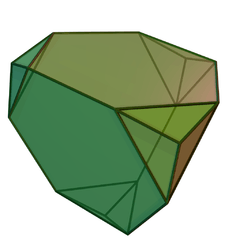Triakis truncated tetrahedron
Not to be confused with truncated triakis tetrahedron.
| Triakis truncated tetrahedron | |
|---|---|
 (Click here for rotating model) (Click here for rotating model) | |
| Type | Conway polyhedron |
| Conway notation | k3tT |
| Faces | 4 hexagons 12 isosceles triangles |
| Edges | 30 |
| Vertices | 16 |
| Properties | convex, space-filling |
In geometry, the triakis truncated tetrahedron is a convex polyhedron made from 4 hexagons and 12 isosceles triangles. It can be used to tessellate three-dimensional space, making the triakis truncated tetrahedral honeycomb.[1][2]
The triakis truncated tetrahedron is the shape of the Voronoi cell of the carbon atoms in diamond, which lie on the diamond cubic crystal structure.[3][4]
Construction
For space-filling, the triakis truncated tetrahedron can be constructed as follows:
- Truncate a regular tetrahedron such that the big faces are regular hexagons.
- Add an extra vertex at the center of each of the four smaller tetrahedra that were removed.
See also
References
- ↑ Conway, John H.; Burgiel, Heidi; Goodman-Strauss, Chaim (2008). The Symmetries of Things. p. 332. ISBN 1568812205.
- ↑ Grünbaum, B; Shephard, G. C. (1980). "Tilings with Congruent Tiles". Bull. Amer. Math. Soc. 3: 951–973. doi:10.1090/s0273-0979-1980-14827-2.
- ↑ Föppl, L. (1914). "Der Fundamentalbereich des Diamantgitters". Phys. Zeitschr. 15: 191–193.
- ↑ Conway, John. "Voronoi Polyhedron". geometry.puzzles. Retrieved 20 September 2012.
This article is issued from Wikipedia - version of the 11/28/2016. The text is available under the Creative Commons Attribution/Share Alike but additional terms may apply for the media files.